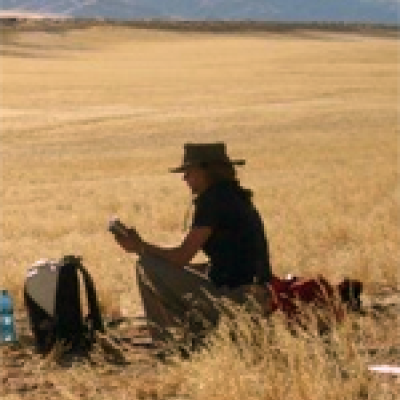Dr Abi Stone
MSc Teaching Associate
Supernumerary Teaching Fellow in Physical Geography at St John's College, Oxford
Member of the Oxford Luminescence Dating Laboratory
Member of the Oxford Water Network
MSc Teaching Associate
Supernumerary Teaching Fellow in Physical Geography at St John's College, Oxford
Member of the Oxford Luminescence Dating Laboratory
Member of the Oxford Water Network
Academic Profile
Abi's research interests lie within understanding the dynamics of dryland systems, including environmental change, landscape dynamics and groundwater resources. She is interested in these processes and dynamics over a range of timescale and applies techniques to address questions about whether groundwater aquifers are part of the active hydrological cycle and questions about the timing and forcing mechanisms of expanding and contracting Quaternary drylands.
Abi is currently working with Prof. Mike Edmunds and Prof. David Thomas, using pore-moisture in sand dune sediments in the Stampriet Basin, in the Kalahari in order to: reconstruct rates of recharge to unconfined groundwater; to understand the production and origin of nitrate in groundwater and produce a palaeomoisture history from the vertical profiles. She is currently developing this research theme following her pilot study undertaken during her Thesiger-Oman International Fellowship from the Royal Geographical Society.
Abi continues to conduct research into the Quaternary palaeoenvironments of dryland areas, with a focus on the Namibian portion of the southern African subcontinent. Currently, this involves luminescence dating of dune material in the Namib Sand Sea and reviewing the palaeoenvironmental and geomorphological history of that region. She aims to test the applicability of pore-moisture techniques to the large Namib Sand Sea dunes, in order to provide a palaeomoisture proxy. She undertook her DPhil thesis on the reconstruction of Quaternary environmental conditions in Namibia using terrestrial proxies at the School of Geography and the Environment, holds an MSc in Quaternary Science from Royal Holloway, University of London, and a BA in Geography from Oxford. She was previously employed within Prof. Heather Viles' Rock Breakdown Laboratory where she coordinated write-up of an English Heritage funded soft capping research project.
Abi is a teaching fellow in physical geography at St John's College, having held previous teaching posts at Keble and Christchurch Colleges and undertaken sabbatical cover teaching at Worcester and St Hilda's Colleges and tutorials for St Catherines College and St Edmund Hall. She also delivers physical geography practical classes as part of the FHS Geographical Research paper and is a tutor for the Quaternary Science and Desert Landscapes and Dynamics optional FHS subjects.
Current Research
The two broad themes of Abi's research involve using chemical tracers in the pore moisture of surface sediments and the reconstruction of Quaternary landscape dynamics.
1. Chemical tracers as novel archives of groundwater recharge and palaeomoisture
This research develops the use of chemical tracers in the pore moisture of near-surface sediments with the aim of improving understanding of dyland hydrological dynamics over both decadal-to-century and century-to-millennial timescales. Abi is fortunate to be working with Prof. Mike Edmunds, an expert on groundwater, hydrogeochemistry and palaeohydrology. Pore moisture chemistry are important for a number of reasons:
- to provide vital scientific data on recharge behaviour and rates to enable those within policy to design effective planning for sustainable use of groundwater supplies.
- to provide information about groundwater quality and the nutrient content of desert sediments.
- as novel palaeoclimate proxy for late Holocene moisture fluctuations in drylands, where traditional proxies relating to moisture are not preserved.
Rainfall in the Desert Sand
This pilot research, funded by the Thesiger-Oman fellowship, BSG small grant and the Fell Fund, tests the application of chloride mass balance (CMB) methods to assess rates of recharge to groundwater through the linear dunes of the southern Kalahari. This research centres on the Stampriet Artesia Basin, a key transboundary groundwater resource in Namibia, Botwsana and South Africa. Results from two test sites in Namibia indicate high suitability, suggest recharge rates are between 7 and 56 mm/y and that sampled dune profiles span multi-decadal timescales. Rainfall over the 2011-2012 rainy season is being analysed to better constrain the chloride input into the sediments. There is now a need to constrain spatial variability across the basin and produce a regional estimate of recharge via this direct mechanism through dune sands, which cover 80% of the basin surface. This is particularly important for the uppermost aquifer layer, from which the majority of groundwater abstraction occurs. Future sampling is planned.
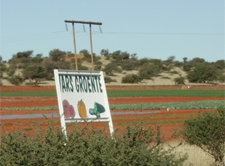
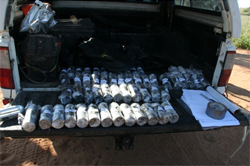
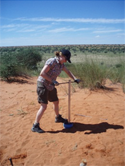
Sampling dunes in the southern Kalahari for dual moisture and OSL analysis, in a region where pumped groundwater is key to agricultural development.
Palaeomoisture records in the Namib Desert
The provision of a moisture proxy using CMB methods in sand-covered regions, such as the vast Namib Sand Sea will be invaluable to answering questions about long term hydrological and environmental dynamics in the southern African subcontinent, which lies at the interface of tropical, subtropical and temperate atmospheric and oceanic circulation systems. It has been suggested there is some coherence in records of progressive aridification over the past few thousand years, but, not all proxy records are in accordance, and the spatial complexity of the environmental response can only be addressed by widening the coverage of sites into regions such as the Namib Sand Sea, about which very little is known over this timescale. Recent notable success in applying the CMB approach to provide information over centennial-to-millennial timescales has been had in the Badain Jaran Desert in China by other researchers. Further development of this novel proxy is of great significance in refining our understanding of environmental change in dryland regions, which are hampered by a paucity of preserved proxy records that relate directly to moisture availability. Sampling is planned later this year.
Abi plans to develop these methods in other dyland regions with a potential collaboration with Prof. Ashok Singhvi in India.
2. Quaternary landscape dynamics using luminescence dating of geoproxies
This represents part of the effort within the Landscape Dynamics research cluster to better understand long-term landscape dynamics using field and laboratory methods. This builds on research undertaken during Abi's DPhil that utilised sand dune, interdune water-lain sediments and fluvial tufa and applied OSL and U-series dating.
Casting new light on Quaternary environmental change in the Namib Desert
The application of optically stimulated luminescence (OSL) in the Namib Desert continues to revolutionise our knowledge of the past dynamics of this dryland environment. OSL has been applied to: (i) complex linear dunes, alongside ground penetrating radar stratigraphy, to establish dune migration rates; (ii) fluvial lithofacies associations, to constrain periods of higher discharge and (iii) aeolian sand, interbedded with carbonate deposits, to provide chronologies for water-lain and interdune sediments. Abi has been reviewing the contribution of these data to enhancing the understanding of palaeoenvironmental and palaeohydrological change on the west coast of Namibia and also dune migration rates for complex linear dune features at the far northern extent of the northern Namib Sand Sea.
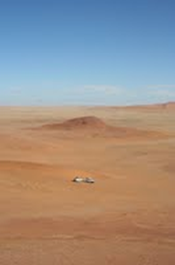
Dating generations of dunes in the dendritic dune morphology in the Namib Desert
This research investigates the age and characteristics of different dune features within the northern Namib. The Namib Desert is one of the earth's oldest deserts. Above the semi-consolidated, tertiary-aged Tsondab Sandstone, lies the Namib Sand Sea (the unconsolidated dunes). The sand sea contains a range of dune types, and some of the largest dune forms found on earth. There is a paucity of chronological control for the dunefield, although cosmogenic nuclide data have recently been used to suggest the region has remained covered in sand for at a million years and luminescence dating in the northern reaches indicates dynamic dune activity over the last five thousand years, with complete overturning of large dune features. This study aims to provide new chronological data in a region of 'dendritic' dune morphology. This morphology is particularly interesting as it contains features of different sizes and orientations that would appear to represent different generations of dunes. The preliminary results from four of the samples suggest that very recent aeolian activity is responsible for the formation of small features (a few metres high), whilst the large linear dunes (up to 100 m high) appear to substantially older than existing luminescence chronologies for the region.
Teaching
Abi teaches physical geography at St John's College, having held previous teaching posts at Keble and Christchurch Colleges and undertaken sabbatical cover teaching at Worcester and St Hilda's Colleges and tutorials for St Catherines College and St Edmund Hall. She teaches the 'Earth System Processes' core course and parts of the 'Geographical Techniques' and 'Geographical Controversies' papers for the Preliminary Examination. She teaches the core 'Earth System Dynamics' paper and components of 'Environmental Geography' and 'Geographical Research' core papers. She coordinates the laboratory-based classes for the 'Geographical Research' paper within the department and assists with the Physical Geography Field Classes. She is a tutor for the Final Honour School Special Subjects 'Dryland Landscapes and Dynamics' and 'The Quaternary Period' and in 2010 taught the latter course for Dr Richard Bailey's sabbatical cover.
Selected Publications
For a list of publications, please see Google Scholar.


